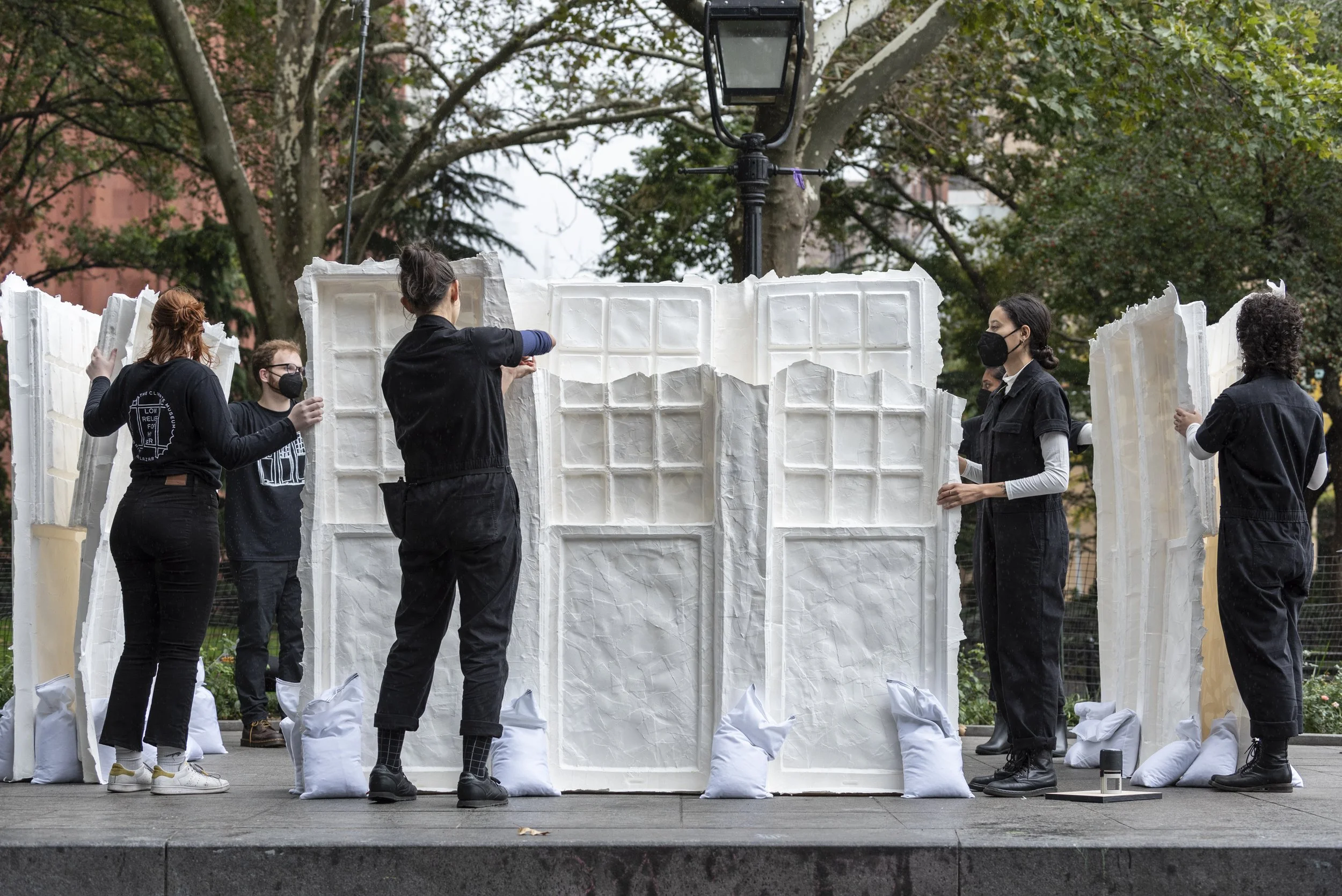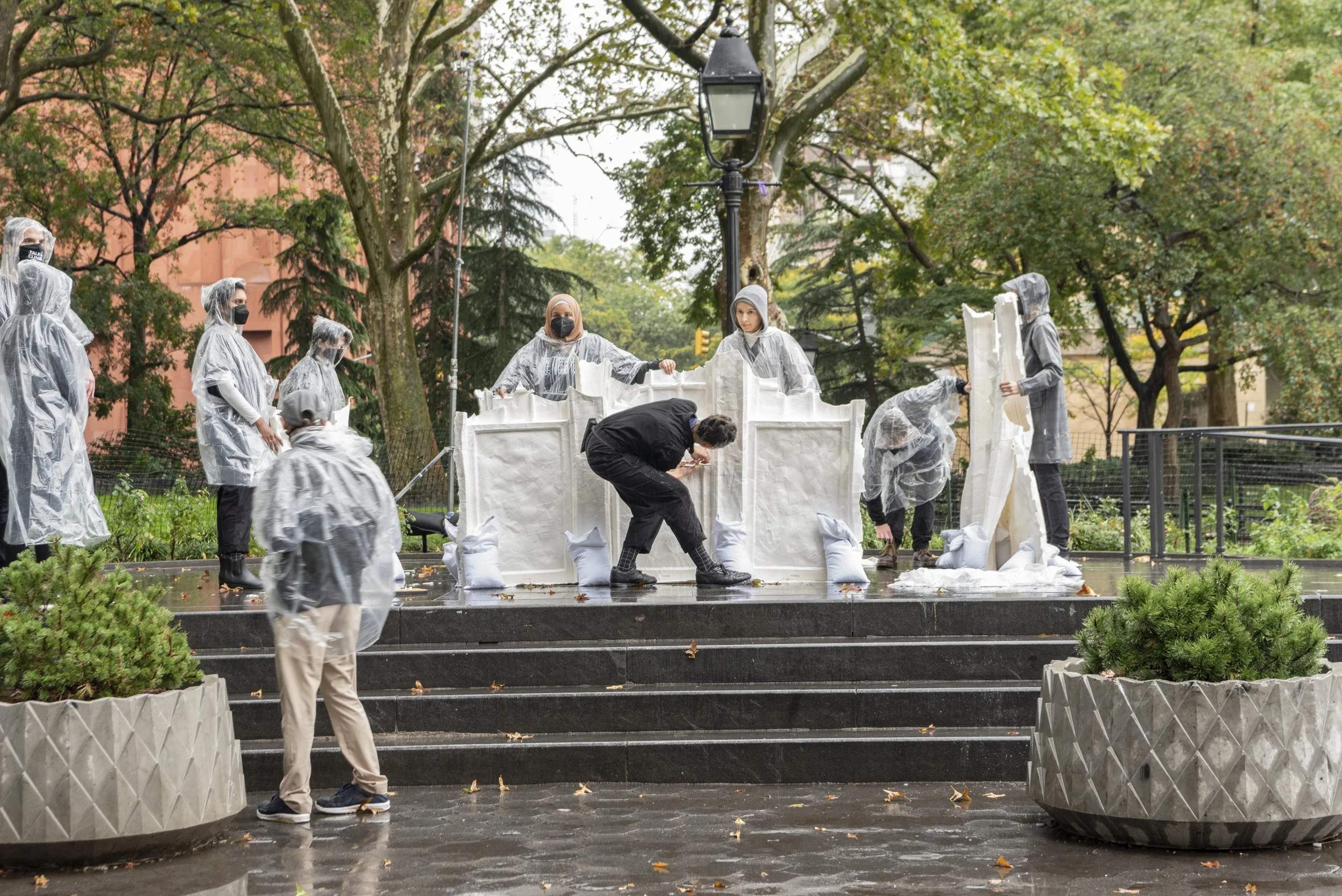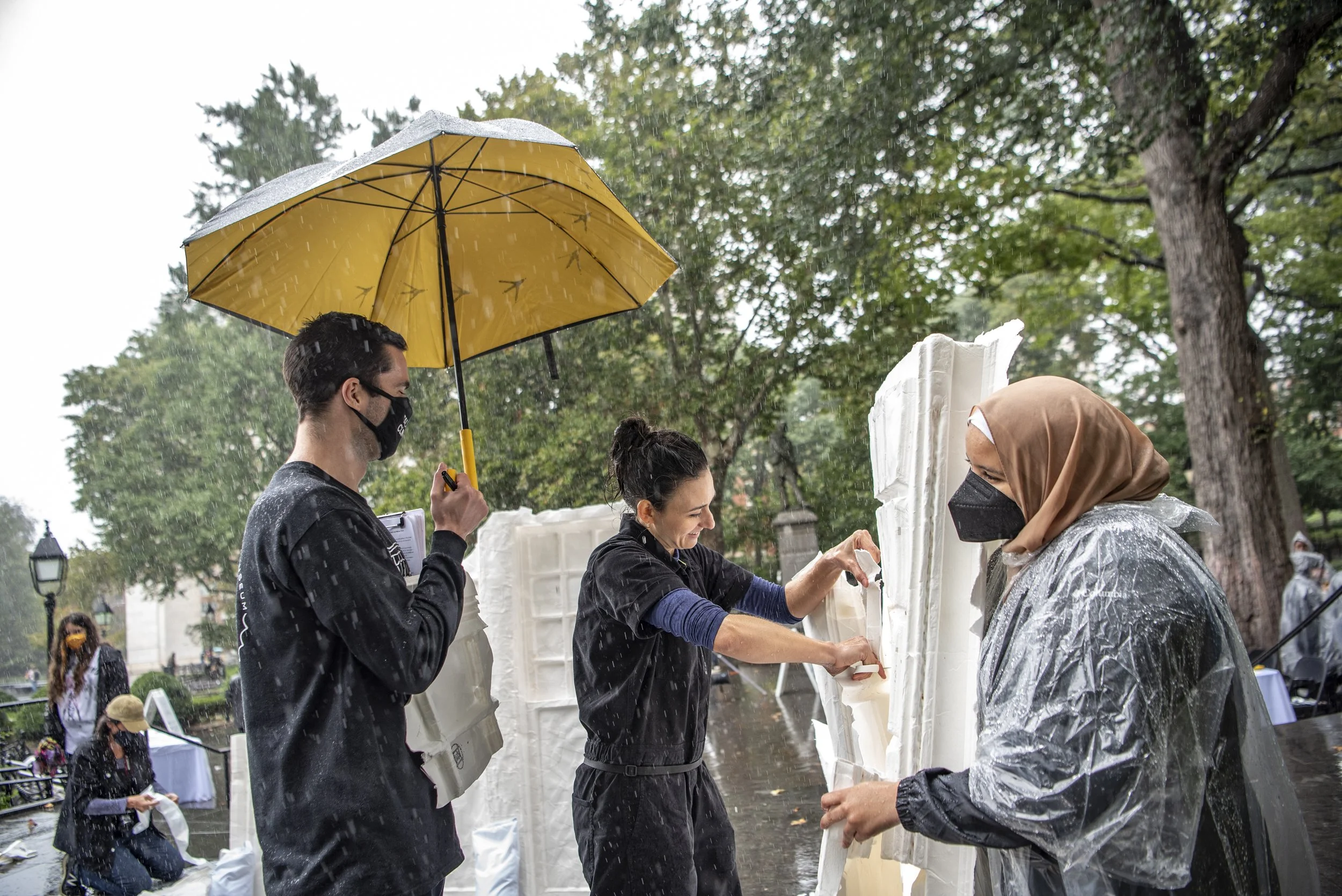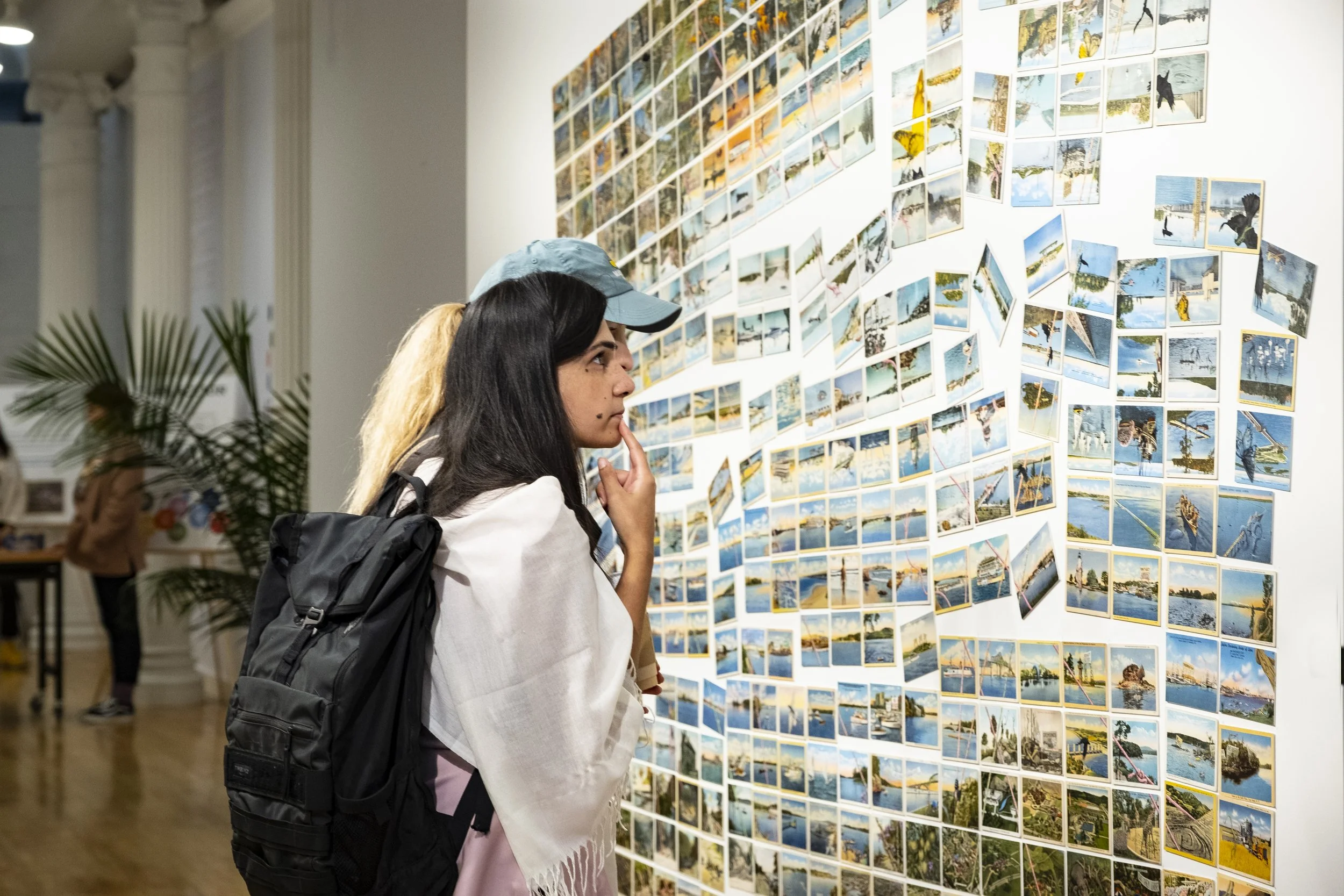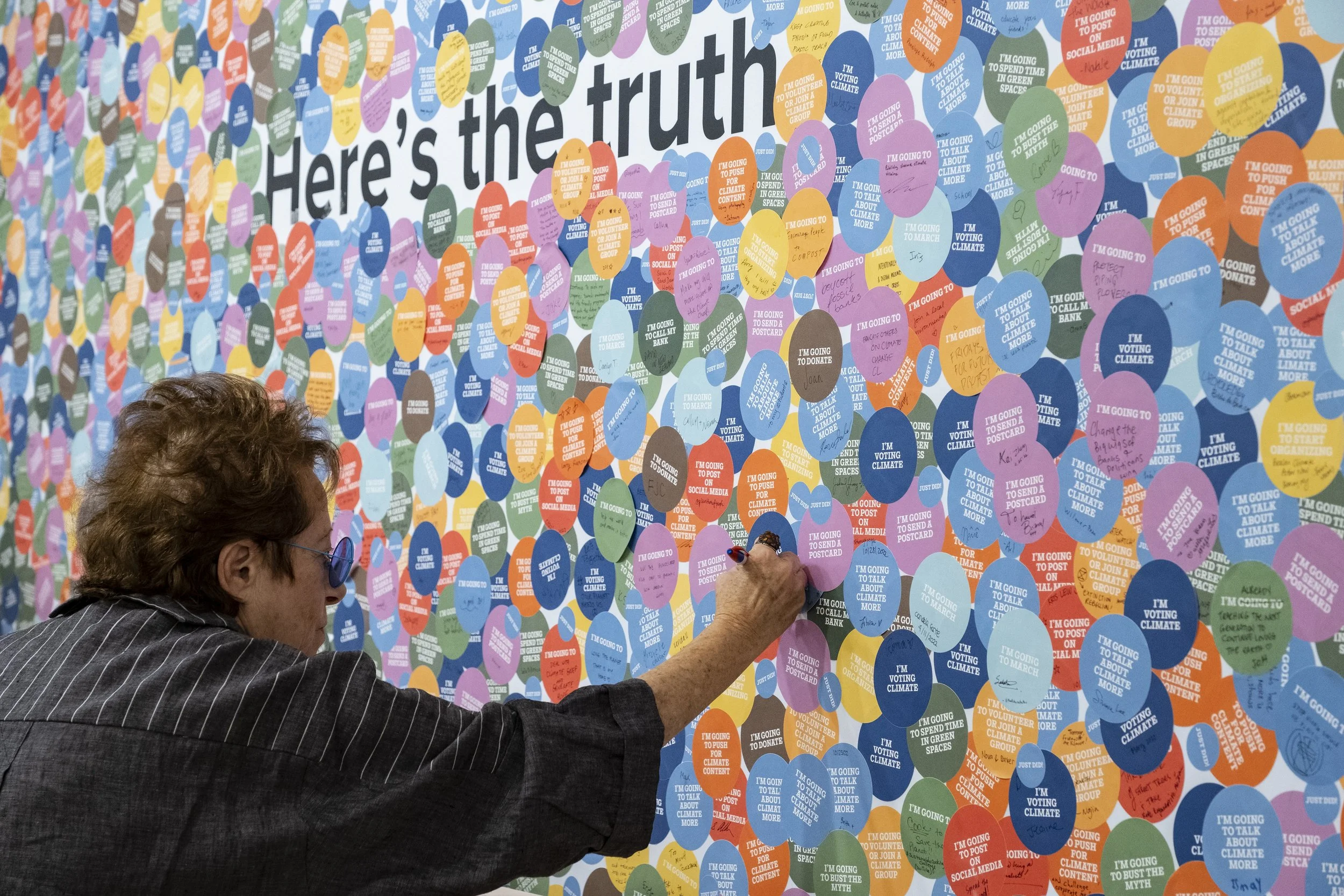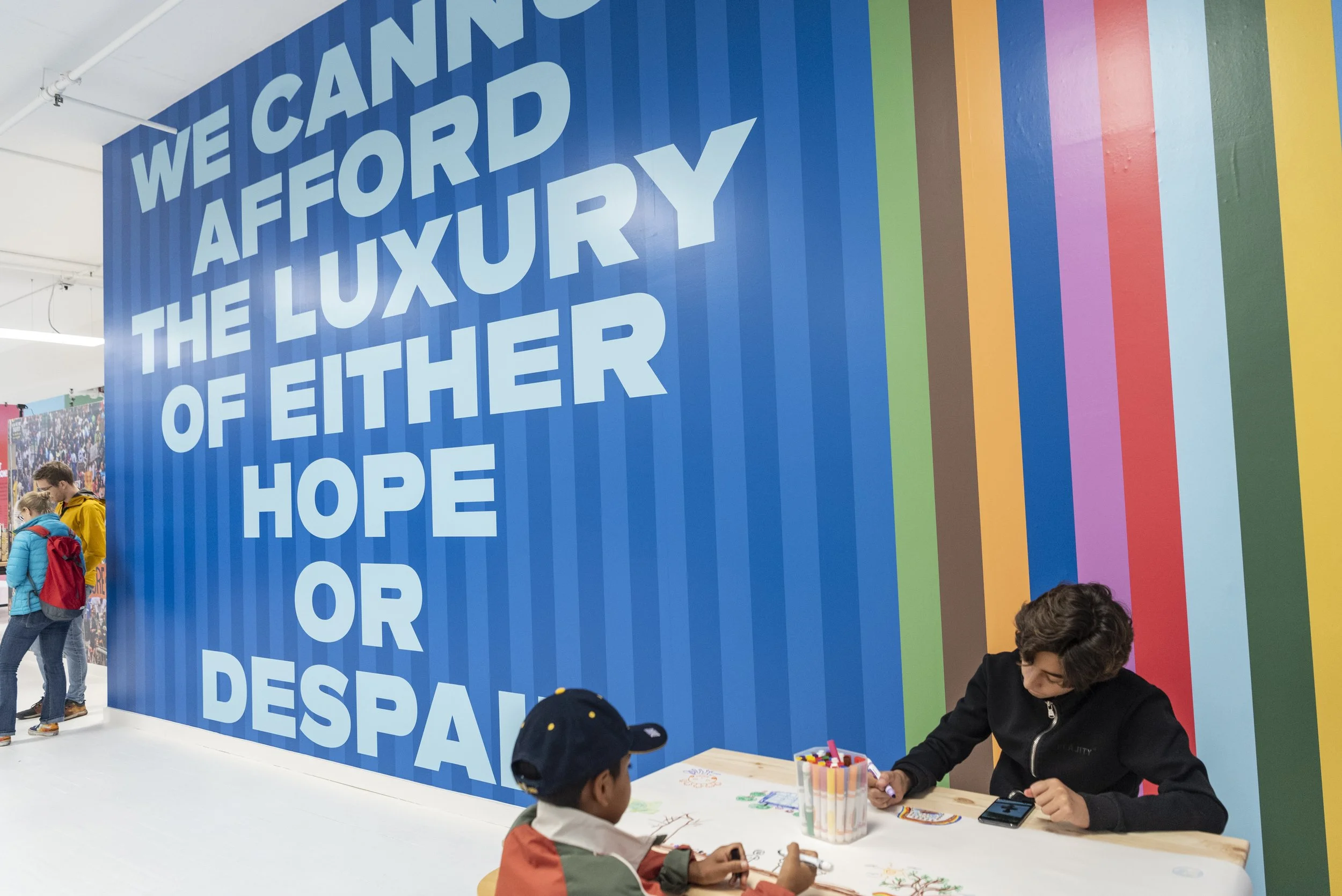News
ART, CARE, AND ACTION IN THE CLIMATE CRISIS By Anais Reyes
Gabriela Salazar, Low Relief for High Water, 2021. Photo: Sari Goodfriend
It is a rainy afternoon in Washington Square Park, New York City, and a teenage girl has suddenly burst into tears.
She is watching a public performance entitled Low Relief for High Water, by artist Gabriela Salazar, happening in the plaza. Salazar used water-soluble paper to create casts of the windows in her childhood home—a Manhattan apartment that she recently moved back into after the birth of her own daughter. The artwork was commissioned by the Climate Museum, and the vulnerability of the paper sculpture to water is a metaphor for the vulnerability of New York City, and of all of our homes, to sea level rise. Through the rain, Salazar is cutting apart the sculpture and giving each piece to viewers and passersby, asking them to protect her home as if it were their own—because it is.
As the girl is overcome with emotion, a volunteer asks if everything is okay. The girl, standing with her mother, responds, “I’m not from here. I was just visiting a college. I’ve been torn about whether to major in art or environmental studies. I love art, but I’m also really scared about climate change. And I never felt that anyone else cared about them both the way that I do—until now.”
A “FALSE SOCIAL REALITY”
In the United States, people often feel that no one cares about climate change.
In truth, the majority of Americans care. A recent survey by Yale University and George Mason University found that 64% of Americans are worried about climate change¹ (about the same as the 66% of Finnish adults who are worried²). However, a 2022 study found that Americans underestimate concern about climate change and support for major climate policies by nearly half. The misperception is so strong that the researchers termed it a “false social reality.”³ Despite the overwhelming worry, 62% of Americans rarely or never talk about climate change.⁴ This in effect creates a “spiral of silence”—people feel that they cannot talk about the climate crisis because no one else is talking about it—leading to a feedback loop of isolation, misunderstanding, and inaction.⁵
If this overwhelming silence is shutting us down and preventing us from acting on climate change, how can we break the cycle?
ART AS A CATALYST
The Climate Museum, the first museum in the United States dedicated to climate change, uses arts and culture as tools to break the spiral of silence. Through interdisciplinary exhibitions and events, the Museum aims to spark dialogue, bring people together, and build momentum for the climate movement. Each program at the Climate Museum ties together art, learning, and action to move people from worry and isolation to agency and empowerment. The Museum highlights climate change as a systemic and social issue that must be addressed through civic and collective action, and each program guides visitors on different ways they can get involved.
Three years after Salazar’s performance, the Acts of Care Symposium—a pARTir project organized by Vapaa Collective—explored connections between art, architecture, and care under the threat of sea level rise. One of the questions presented to the symposium speakers asked us to reflect on the evolving definitions of care in response to the climate crisis. What does care actually mean in practice? How can it scale, from the personal to the global level? Here I will discuss some key moments from the Climate Museum’s history that explore these questions.
ART AS CARE
Gabriela Salazar’s Low Relief for High Water was a one-day interactive installation that used the visual language of architecture—a familiar structure from within a home—to explore the choice and act of protection. In taking a piece of the water-soluble artwork, the participant could choose to care for, neglect, or even destroy it—a parallel for the choices we make (whether actively or passively) to protect our shared home, planet Earth, from rising seas. Originally organized to commemorate the 50th anniversary of Earth Day in April 2020, the event was postponed until October 2021 because of the COVID-19 pandemic. As with all Climate Museum programs, the event also featured civic and social engagement opportunities: viewers could sign postcards to their elected representatives asking them to support more climate policies; talk with a climate psychologist equipped to answer questions about climate anxiety; or take a Polaroid picture and write a note of reflection about the performance, which was then displayed with the photos and reflections of other participants.
Gabriela Salazar, Low Relief for High Water, 2021. Photo: Sari Goodfriend
Gabriela Salazar, Low Relief for High Water, 2021. Photo: Sari Goodfriend
On the day of the performance—the culmination of a two year long project—the weather turned, and the unanticipated humidity, rain, and wind caused the water-soluble paper sculptures to buckle and collapse. Museum staff and volunteers jumped in to protect the artwork, picking it up off the ground and supporting it upright. However, the damage was already done. The pieces had lost their structural integrity. What had been planned as a choreographed performance by the artist and three assistants became an all-hands-on-deck crisis.
As the wind and rain continued through the afternoon, supporters cycled in and out to hold up the artwork as Salazar cut it apart, gave the pieces to the audience, and persisted with the performance. Some parts of the sculpture became too water-logged and were unsalvageable, but most of the sculpture was able to be saved and given to participants. Although the day did not go according to plan, the choice of the supporters to step up during an emergency, and the act of selfless endurance to protect something we all cared about from the storm—to literally protect Salazar’s home—added a valuable layer of meaning to the artwork.
EXHIBITIONS AS CARE
In 2023, the Climate Museum presented an exhibition that showcased an artwork entitled Someday, all this by David Opdyke. A scene created out of 400 hand-altered vintage postcards told a story about sea level rise, destruction, and displacement with a touch of absurdity and humor. As part of this exhibition, we created an “action center” where people could commit to taking different civic and collective actions. The action options included contacting elected representatives, attending marches, joining local environmental groups, voting for politicians that support climate policy, talking about climate, and more.
David Opdyke, Someday, all this, 2021 (Part of the Climate Museum Pop-Up, 2022-23). Photo: Sari Goodfriend
David Opdyke, Someday, all this, 2021 (Part of the Climate Museum Pop-Up, 2022-23). Photo: Sari Goodfriend
For each action commitment taken, visitors could place a corresponding sticker on a nearby wall. Inspired by Yayoi Kusama’s Obliteration Room, this sticker wall acted as a visual representation of the collective—of everyone else who cares about climate change, who stood where you stood in this very gallery, and who chose to commit to action. Many people signed their names, included the date, and wrote a message—a way to leave their mark on the exhibition. After the seven-month run of the show, the wall was covered with stickers. Some even overflowed onto adjacent walls. This was our second iteration of the sticker wall, and it continues to be an interactive exhibit that we return to because of its effectiveness. It captures the importance of seeing everyone else who cares about this issue, the strength of our actions when combined with the actions of others, and our potential as a collective for transformational change. Through these sticker walls we are able to create a sense of direction, connection, and motivation.
CARE AND HOPE IN THE CLIMATE CRISIS
In the Climate Museum’s most recent exhibition, The End of Fossil Fuel, one wall read in massive letters, “We cannot afford the luxury of either hope or despair,”—a quote from a friend of the Museum, Olatunde Johnson. It was a statement on the need for urgent and committed action, and the pitfalls of allowing either hope or despair to make us passive.
The End of Fossil Fuel, 2023-24. Photo Sari: Goodfriend
Care, like hope, cannot flourish in passivity nor in isolation. To care is to act, and to act is to care. Care involves coming together with others to put in the work. If you care about something, especially in times of crisis, you do not wait around hoping for things to get better on their own. You run to hold up that collapsing sculpture, knowing full well that the rain might drench you in the process, but also knowing that you will not be doing it alone. Our understanding of care must transform from passive to active and from individual to collective.
A study conducted by George Mason University on The End of Fossil Fuel found that after viewing the exhibition, visitors felt more confident and more determined to talk about climate⁶—an action that experts say is critical to building a better future⁷. Artists and cultural institutions have the power to help those who are worried but silent turn the care they feel into care they do. Now more than ever is a critical time to put that power to good use.
Anais Reyes is the Senior Exhibitions Associate of Curation at the Climate Museum, where she works on planning, researching, and writing exhibitions that educate and empower visitors. She is motivated by the potential and urgent need for social and cultural approaches to climate solutions. She has previously worked at the American Museum of Natural History, the New Museum of Contemporary Art, and the Whitney Museum of American Art. She received her BFA from the University of Wisconsin-Madison with concentrations in curation and entrepreneurship, and is currently pursuing a post-baccalaureate certificate in ecology, climate, and social sciences at Columbia University.
This article has been commissioned as part of the Finnish Cultural and Academic Institutes' pARTir initiative. Vapaa Collective’s participation in the Archtober 2024 program through the Architectural Acts of Care project was commissioned by the Finnish Cultural Institute in New York and the Finnish Institute in the UK and Ireland in partnership with the Consulate General of Finland in New York. pARTir initiative was funded by the European Union – NextGenerationEU.
Read more about Acts of Care Symposium and pARTir.
